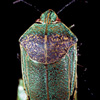
 GOOD GUYS & BAD GUYS
GOOD GUYS & BAD GUYS 

 |
 GOOD GUYS & BAD GUYS
GOOD GUYS & BAD GUYS 
|
 |
[Good Guys & Bad Guys Home | About This Site | Card List | HBS Home | Bishop Museum Home
BAD GUY  |
||
 |
21.
Bristle-Nosed Catfish
Ancistrus cf. temminckii was first found on O`ahu in 1985.
Species in the genus Ancistrus are distinctive because of their
prominent snout tentacles occurring in both sexes, with the tentacles
having the greatest development in breeding males. The largest Ancistrus
cf. temminckii specimen collected in Manoa Stream was 78 mm. |
|
| Photo by Ronald Englund and David Preston | ||